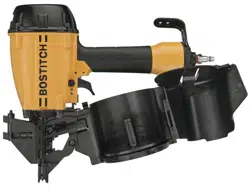Loading ...
Loading ...
Loading ...

-6-
Pivot Pin
Selector
To operate the nailer in sequential trip mode:
1. Depress the contact trip firmly against the work surface.
2. Depress the trigger.
A nail will fire each time the trigger is depressed as long as the contact trip remains
depressed.
CONTACT TRIP -
1. Push and hold in pivot pin while rotating the selector 180° clockwise to the contact trip position .
2. Ensure the selector is fully seated in the new position.
To operate the nailer in contact trip mode:
1. Depress the trigger.
2. Push the contact trip against the work surface. As long as the trigger is depressed, the tool will fire a nail
every time the contact trip is depressed. This allows the user to drive multiple nails in sequence.
Do not keep trigger depressed when tool is not in use.
AIR SUPPLY AND CONNECTIONS
Do not use oxygen, combustible gases, or bottled gases as a power source for this
tool as tool may explode, possibly causing injury.
Do not connect tool to any air supply which could potentially exceed
200p.s.i.g.(14kg/cm
2
).
FITTINGS:
Install a male plug on the tool which is free flowing and which will release air pressure from the tool when
disconnected from the supply source.
HOSES:
Air hoses should have a minimum of 150 p.s.i. (10.5 kg/cm
2
) working pressure rating or 150 percent of the
maximum pressure that could be produced in the air system. The supply hose should contain a fitting that will
provide “quick disconnecting” from the male plug on the tool.
SUPPLY SOURCE:
Use only clean regulated compressed air as a power source for this tool. NEVER USE OXYGEN,
COMBUSTIBLE GASES, OR BOTTLED GASES, AS A POWER SOURCE FOR THIS TOOL AS TOOL
MAY EXPLODE.
REGULATOR:
A pressure regulator with an operating pressure of 0 - 125 p.s.i.g. (0 - 8.79 kg/cm
2
) is required to control the
operat ing pressure for safe operation of this tool. Do not connect this tool to air pressure which can potentially
exceed 200 p.s.i. (14 kg/cm
2
) as tool may fracture or burst, possibly causing injury.
OPERATING PRESSURE:
Do not exceed recommended maximum operating pressure as tool wear will be greatly increased. The air
supply must be capable of maintaining the operating pressure at the tool. Pressure drops in the air supply can
reduce the tool’s driving power. Refer to “Tool Specifications” for setting the correct operating pressure for the
tool.
Loading ...
Loading ...
Loading ...
